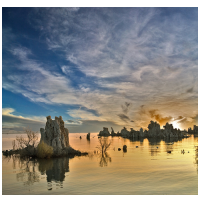Mono Lake Accord May Mark End to 70 Years of Exploitation and Rancor
 Morning at Mono Lake (photo: uncredited at Los Angeles Times)
Morning at Mono Lake (photo: uncredited at Los Angeles Times)
L.A. is celebrating the 100th anniversary of the Los Angeles Aqueduct—whose connection to the Owens Valley facilitated the destruction of Mono Lake and ruined much of the surrounding basin—by reaching an accord that should conclude decades of legal fighting.
The Los Angeles Department of Water and Power (LADWP) Board of Commissioners is scheduled to vote Tuesday on a settlement of a dispute that has pitted thirsty urban inhabitants against conservationists since L.A. routed water to the aqueduct from tributaries feeding the lake in the early 1940s, according to the Los Angeles Times.
Earlier court decisions settled many of the issues between the combatants, but this agreement, which will not affect the depth of Mono Lake, promises to put a finishing touch on the dispute. Under the accord, a $15 million adjustable gate will be built in Grant Dam to regulate the flow of water into Rush Creek.
The releases of water will mimic seasonal flows, enhancing local flora and fauna and helping the trout population. Fisheries, streamside forests, birds and wildlife will benefit along Mono Basin streams, and Los Angeles will be able to import roughly 12,000 acre-feet of water.
“We're expecting a huge leap forward in the recovery of an estimated 19 miles of stream corridors affected by this agreement,” Geoffrey McQuilkin, executive director of the Mono Lake Committee, told the Times.
A final agreement, fueled by years of animosity, has been more elusive than the Sierra Sasquatch of Mono Lake.
The lake is located in Mono County near Yosemite National Park, about 276 miles north of Los Angeles. In 1941, nearly three decades after construction of the aqueduct connected Los Angeles to water supplies in the Owens Valley, additional connections were made to creeks that fed the lake.
Over the next 41 years, Mono Lake lost half its water and 45 feet of depth. Its salt concentration, which already exceeded that of the ocean, doubled. Fish died, migratory birds lost an important way station, and surrounding wetlands and woodland areas suffered mightily.
In 1979, the Mono Lake Committee and the National Audubon Society sued the LADWP, arguing that redirecting the creeks violated the public trust doctrine, which says that navigable bodies of water must be managed for the benefit of all. The lawsuit zigzagged through the courts before the California Supreme Court ruled against the city in 1984.
Further lawsuits were filed, and the State Water Resources Control Board settled the issue in 1994 after a series of hearings that lasted 44 days. Board Vice-Chair Marc Del Piero, the sole hearing officer, established what were called “significant public trust protection and eco-system restoration standards,” requiring the LADWP to release water into Mono Lake to raise the water level 20 feet above its then-current level of 25 feet, although still below the 1941 level.
The board continued to monitor compliance with its ruling and in 1998 ordered the implementation of stream and waterfowl habitat restoration measures that both sides had finally agreed to. The average depth of Mono Lake is now 56 feet.
–Ken Broder
To Learn More:
L.A., Conservationists Reach Agreement to Repair Mono Lake Damage (by Louis Sahagun, Los Angeles Times)
The Troubled Relationship between LA and Mono Lake (USC Dornsife)
- Top Stories
- Controversies
- Where is the Money Going?
- California and the Nation
- Appointments and Resignations
- Unusual News
- Latest News
- California Forbids U.S. Immigration Agents from Pretending to be Police
- California Lawmakers Urged to Strip “Self-Dealing” Tax Board of Its Duties
- Big Oil’s Grip on California
- Santa Cruz Police See Homeland Security Betrayal in Use of Gang Roundup as Cover for Immigration Raid
- Oil Companies Face Deadline to Stop Polluting California Groundwater





